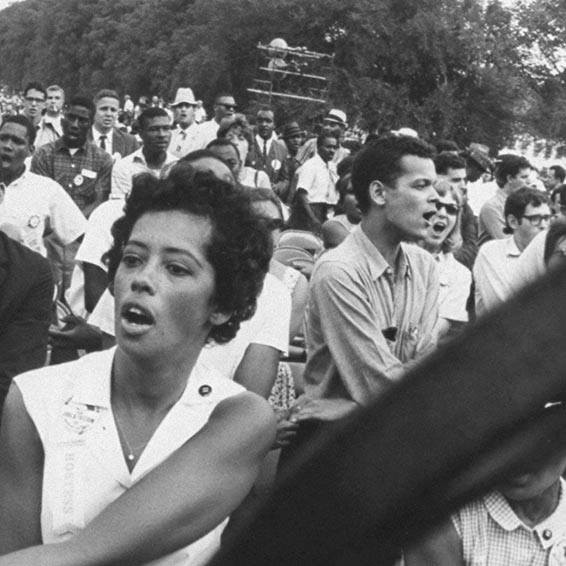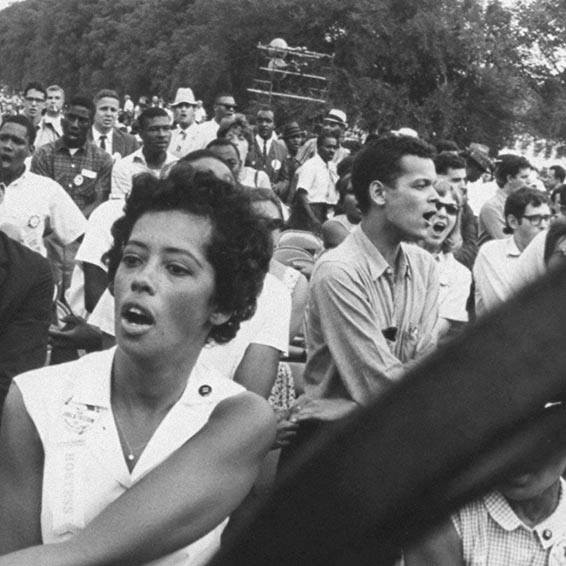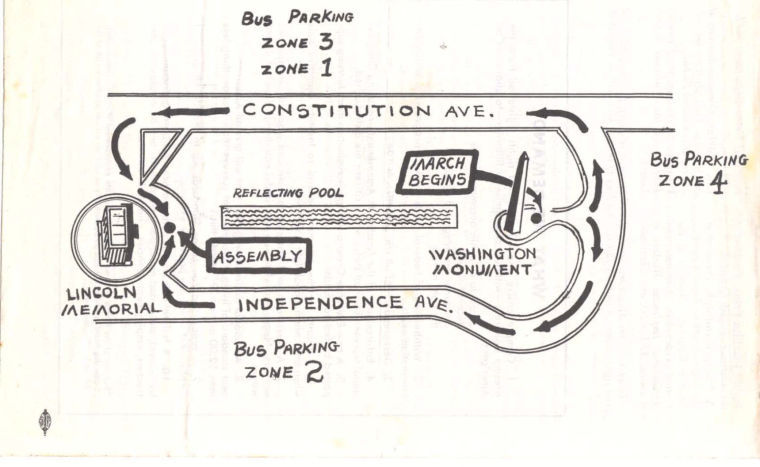Aug. 28, 1963: Julian Bond was on the National Mall in Washington, fighting for his basic rights as part of the Student Nonviolent Coordinating Committee.
Fifty years later, he was back on the Mall, witnessing the progress and change in the two anniversary marches over the past two weeks. But Bond reminded an audience in the Clarice Smith Performing Arts Center not to be naive amid the celebration.
“Racism is alive and well,” he said.
The first speaker in the center’s two-day symposium, Civil War to Civil Rights: The Well-Being of a Nation, Bond detailed his experiences at the first march, discussing the tumult and violence of 1963 — including the assassinations of President Kennedy and civil rights activist Medgar Evers — juxtaposed with the peace of the march.

Fifty years later
Photo courtesy of Francis Miller (Time & Life Pictures/Getty Images). Julian Bond spoke at CSPAC’s Civil Rights Symposium. He is the man on the right in the photograph (above) of the original March on Washington.
The symposium, which also runs today , is for the center’s part in the National Civil War Project, a collaboration between universities and theaters to explore civil rights from past to present to future.
Each university is paired with a local theater; CSPAC’s regional partner is Center Stage, Maryland’s state theater in Baltimore. They are joined by the Alliance Theatre and Emory University in Atlanta; American Repertory Theater and Harvard University in Cambridge, Mass.; and Arena Stage at the Mead Center for American Theater and George Washington University in Washington.
The goals of the symposium, said Paul Brohan, director of artistic initiatives for CSPAC, are to “recommit to moving the civil rights movement forward as it becomes a more diverse movement” with the emerging issues of the future.
As Bond was speaking, visual journalist Ellen Lovelidge outlined his biggest points and drew out his narrative journey in color on a large white piece of paper at the edge of the Kay Theatre — just as she’ll do for the rest of the symposium.
One of Bond’s tasks at the first March on Washington was handing a Coca-Cola to Sammy Davis Jr., who, Bond said, “held out his hand like a pistol and said, ‘Thanks, kid.’” Bond remembers it as one of his favorite memories of the march.
Bond compared racism in America to a moving sidewalk. There are active racists, he said, that continue to walk forward on the sidewalk, progressing racism. But those who are just standing on the moving sidewalk — the passive racists — are still propelling racism forward.
The work and the progress must continue in this age, he said — four decades of ups and downs for civil rights and the first black president won’t cut it.
“I’m optimistic by nature,” Bond said. “Don’t let anyone tell you, ‘You can’t do it.’”
After Bond’s tale, a “creative framing” session took place with choreographers Liz Lerman and Vincent Thomas. They told stories of key moments that helped them understand some piece of race and encouraged audience members to do so, too. They then pieced together their stories, Bond’s stories and a few audience members’ stories, and turned them into a dance interpretation — including a turn of the head as a nod to African-American migration from south to north.

March on Washington, Program, 8/28/63
“We have this living, breathing, incredible imagination,” Lerman said. “If we just let her/him/it in, sometimes it’s this kind of thing that happens.”
After the show, many in the audience were struck by Bond’s power and the artistic interpretations that followed. Gloria Aparicio Blackwell , who is from Venezuela and is the director of this university’s Office of Community Engagement, said she found many commonalities between the challenges faced in the Latino and African-American communities. Zainab Okolo, an undergraduate coordinator in the public health school, said Bond’s words were important because, unlike others, he didn’t assert that racism was gone.
The audience performed the story dance several times. During one of the last repetitions, Bond walked into the audience and posed for a quick photo with some fans. In his tan jacket and white speckled hair, Bond slid into one of the first few rows as music played and everyone around him danced.
By the end, he had his hands up.
Civil War to Civil Rights: The Well-Being of a Nation runs from 10 a.m. to 5:30 p.m. today at the Clarice Smith Performing Arts Center. Tickets are free, but registration is required. Visit claricesmithcenter.umd.edu for more details.
Julian Bond, who spoke at CSPAC’s Civil Rights Symposium, is the man on the right in the photograph (above) of the original March on Washington.
Julian Bond speaks at the Clarice Smith Center’s two-day symposium, Civil War to Civil Rights: The Well-Being of a Nation.






